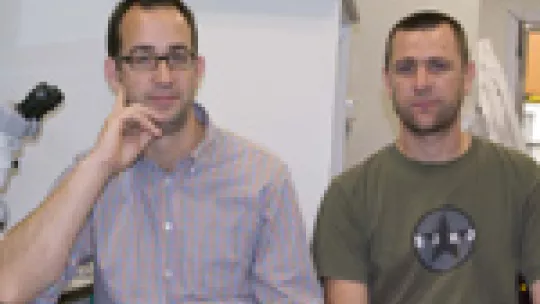Images
The finding made in the fruit fly may provide clues to address problems such as the proliferation of malignant cells and tumour growth in humans
A study performed by researchers at the Institute for Research in Biomedicine (IRB Barcelona) on the fruit fly, Drosophila melanogaster, unveils how distinct signaling pathways operate between neighboring cells in order to activate the cell proliferation machinery that results in the organized growth of the fly wing. The signaling pathways involved in this process are also conserved in humans, and when altered in diverse tissues give rise to the appearance of different types of cancer, including cancer of the colon and skin, and leukemia. The study has been undertaken in the Cell and Development Biology Laboratory headed by ICREA Research Professor, Marco Milán, at IRB Barcelona, and has been released in and advanced online format by the EMBO Journal.
The researchers have shown that the Notch and Wnt/Wingless signaling pathways exert control over the cell division machinery through two gene effectors, the proto-oncogen dMyc and the micro-RNA bantam. Regulated by Notch and Wnt/Wingless, these two genes instruct another gene, E2F, to activate the cell division machinery. "All the components were already known but we have clarified the order in the signaling cascade and the interaction between the molecular elements that regulate proliferation for the correct development of the wing", explains Héctor Herranz, first author of the article.
Marco Milán: "Diseases like cancer cannot be understood without taking into account how the distinct molecular elements are integrated".
Notch and Wnt/Wingless play a key role in embryo development, cell growth (proliferation) and the transformation of cells into specialized types (differentiation). The interesting feature is that these two pathways are highly conserved in humans and when mutations arise tumors appear. The fruit fly wing is a vital experimental model to find future biomedical applications. Marco Milán goes on to say, "this finding could provide clues about how to repress the cell proliferation signals in cancer".
The context is relevant
Furthermore, the research has elucidated the relationship between Notch and Wnt/Wingless in the control of proliferation and the development of the fly wing. In fact, Notch has a repressor function, that is to say, when it is activated the cell division machinery is arrested. Only when Wnt/Wingless starts to work is Notch silenced, thereby triggering the cascade of genes that allow proliferation. “Notch works in this context as a tumor suppressor”, explains Milán, “while Wnt/Wingless acts as an oncogen, that is, by canceling the action of Notch it allows the cell division machinery to operate”. But the fundamental point for the researchers is that Notch and Wnt/Wingless can interchange their roles depending on the context in which they are operating because the true executors of the action are the genes that these proteins regulate, in this case dMyc and bantam.
Researchers ask how, for example, in function of the tissue that is affected, Notch can serve as a “tumor suppressor” or as an oncogene. The conclusions drawn from this study, point to effectors being regulated by this pathway. “We have highlighted the importance of the context in which these signaling pathways work and that knowledge about the underlying regulatory elements is crucial to understand how a certain function is performed”, explains Herranz.
According to Milán, diseases like cancer cannot be understood without taking into account how the distinct elements are integrated: that is to say, crosstalk between neighboring cells, effector genes and cell cycle machinery. “Now we must look for similarities in vertebrates and humans to see whether these elements work in the same way in diseases”, concludes.
Reference article:
A Wingless and Notch double-repression mechanism regulates G1-S transition in the Drosophila wing.
Héctor Herranz, Lidia Pérez, Francisco A. Martín, and Marco Milán
EMBO J, 2008 (e-pub ahead of print)
About IRB Barcelona
The Institute for Research in Biomedicine (IRB Barcelona) pursues a society free of disease. To this end, it conducts multidisciplinary research of excellence to cure cancer and other diseases linked to ageing. It establishes technology transfer agreements with the pharmaceutical industry and major hospitals to bring research results closer to society, and organises a range of science outreach activities to engage the public in an open dialogue. IRB Barcelona is an international centre that hosts 400 researchers and more than 30 nationalities. Recognised as a Severo Ochoa Centre of Excellence since 2011, IRB Barcelona is a CERCA centre and member of the Barcelona Institute of Science and Technology (BIST).






